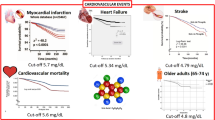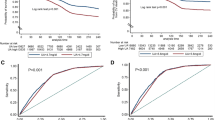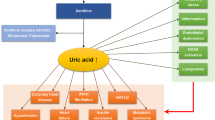Abstract
The relevance of cardiovascular role played by levels of serum uric acid is dramatically growing, especially as cardiovascular risk factor potentially able to exert either a direct deleterious impact or a synergic effect with other cardiovascular risk factors. At the present time, it still remains undefined the threshold level of serum uric acid able to contribute to the cardiovascular risk. Indeed, the available epidemiological case studies are not homogeneous, and some preliminary data suggest that the so-called “cardiovascular threshold limit” may substantially differ from that identified as a cut-off able to trigger the acute gout attack. In such scenario, there is the necessity to clarify and quantify this threshold value, to insert it in the stratification of risk algorithm scores and, in turn, to adopt proper prevention and correction strategies. The clarification of the relationship between circulating levels of uric acid and cardio-nephro-metabolic disorders in a broad sample representative of general population is critical to identify the threshold value of serum uric acid better discriminating the increased risk associated with uric acid. The Uric acid Right for heArt Health (URRAH) project has been designed to define, as primary objective, the level of uricemia above which the independent risk of cardiovascular disease may increase in a significantly manner in a general Italian population.
Similar content being viewed by others
References
Walace KL, Riedel AA, Joseph-Ridge N, Wortnmann R. Increasing prevalence of gout and hyperuricemia over 10 years among older adults in a managed care population. J Rheumatol. 2004;31:1582–7.
Roddy E, Doherty M. Epidemiology of gout. Arthritis Res Ther. 2010;12:223.
Trifirò G, Morabito P, Cavagna L, Ferrajolo C, Pecchioli S, Simonetti M, Bianchini E, Medea G, Cricelli C, Caputi AP, Mazzaglia G. Epidemiology of gout and hyperuricaemia in Italy during the years 2005–2009: a nationwide population-based study. Ann Rheum Dis. 2013;72(5):694–700.
Zhu Y, Padya BJ, Vjoi HK. Prevalence of gout and hyperuricemia in the US general population: The National Health and Nutrition Examination Survey 2007–2008. Arthritis Rheum. 2011;63:3136–41.
Miao Z, Li C, Chen Y, Zhao S, Wang Y, Wang Z, Chen X, Xu F, Wang F, Sun R, Hu J, Song W, Yan S, Wang CY. Dietary and lifestyle changes associated with highprevalence of hyperuricemia and gout in the Shandong coastal cities of Eastern China. J Rheumatol. 2008;35(9):1859–64.
Choi HK, Atkinson K, Karlson EW, Curhan G. Obesity, weight change, hypertension, diuretic use, and risk of gout in men: the Health Professionals Follow-up Study. Arch Intern Med. 2005;165:742–8.
Choi HK, Atkinson K, Karlson EW, Willett W, Curhan G. Purine-rich foods, dairy and protein intake, and the risk of gout in men. N Engl J Med. 2004;350:1093–103.
Choi HK, Atkinson K, Karlson EW, Willett W, Curhan G. Alcohol intake and risk of incident gout in men: a prospective study. Lancet. 2004;363:1277–81.
Choi HK, Curhan G. Soft drinks, fructose consumption, and the risk of gout in men: prospective cohort study. BMJ. 2008;336:309–12.
Choi JW, Ford ES, Gao X, Choi HK. Sugar-sweetened soft drinks, diet soft drinks, and serum uric acid level: the Third National Health and Nutrition Examination Survey. Arthritis Rheum. 2008;59:109–16.
Fishberg AM. The interpretation of blood uric acid in hypertension. Arch Intern Med (Chic). 1924;34:503–7.
Glynn RJ, Campion EW, Silbert JE. Trends in serum uric acid levels 1961–1980. Arthritis Rheum. 1983;26:87–93.
Borghi C. The role of uric acid in the development of cardiovascular disease. Curr Med Res Opin. 2015;31(Suppl 2):1–2.
Borghi C, Rosei EA, Bardin T, Dawson J, Dominiczak A, Kielstein JT, Manolis AJ, Perez-Ruiz F, Mancia G. Serum uric acid and the risk of cardiovascular and renal disease. J Hypertens. 2015;33(9):1729–41.
Desideri G, Castaldo G, Lombardi A, Mussap M, Testa A, Pontremoli R, Punzi L, Borghi C. Is it time to revise the normal range of serum uric acid levels? Eur Rev Med Pharmacol Sci. 2014;18(9):1295–306.
Grassi D, Desideri G, Di Giacomantonio AV, Di Giosia P, Ferri C. Hyperuricemia and cardiovascular risk. High Blood Press Cardiovasc Prev. 2014;21(4):235–42.
Feig DI, Kang DH, Johnson RJ. Uric acid and cardiovascular risk. N Engl J Med. 2008;359:1811–21.
Kuo CF, Grainge MJ, Mallen C, Zhang W, Doherty M. Comorbidities in patients with gout prior to and following diagnosis: case-control study. Ann Rheum Dis. 2016;75(1):210–7.
Choi HK, Ford ES, Li C, Curhan G. Prevalence of the metabolic syndrome in patients with gout: the Third National Health and Nutrition Examination Survey. Arthritis Rheum. 2007;57(1):109–15.
Richette P, Perez-Ruiz F, Doherty M, Jansen TL, Nuki G, Pascual E, Punzi L, So AK, Bardin T. Improving cardiovascular and renal outcomes in gout: what should we target? Nat Rev Rheumatol. 2014;10(11):654–61.
Park JJ, Roudier MP, Soman D, Mokadam NA, Simkin PA. Prevalence of birefringent crystals in cardiac and prostatic tissues, an observational study. BMJ Open. 2014;4(7):e005308.
Nozue T, Yamamoto S, Tohyama S, Fukui K, Umezawa S, Onishi Y, Kunishima T, Hibi K, Terashima M, Michishita I. Correlations between serum uric acid and coronary atherosclerosis before and during statin therapy. Coron Artery Dis. 2014;25(4):343–8.
Tamariz L, Hernandez F, Bush A, Palacio A, Hare JM. Association between serum uric acid and atrial fibrillation: a systematic review and meta-analysis. Heart Rhythm. 2014;11(7):1102–8.
Kim SY, Guevara JP, Kim KM, Choi HK, Heitjan DF, Albert DA. Hyperuricemia and risk of stroke: a systematic review and meta-analysis. Arthritis Rheum. 2009;61(7):885–92.
Andres M, Quintanilla MA, Sivera F, Sanchez-Paya J, Pascual E, Vela P, Ruiz-Nodar JM. Silent monosodium urate crystal deposits are associated with severe coronary calcification in asymptomatic hyperuricemia: an exploratory study. Arthritis Rheumatol. 2016;68(6):1531–9.
Grayson PC, Kim SY, LaValley M, Choi HK. Hyperuricemia and incident hypertension: a systematic review and meta-analysis. Arthritis Care Res (Hoboken). 2011;63(1):102–10.
Viazzi F, Rebora P, Giussani M, Orlando A, Stella A, Antolini L, Valsecchi MG, Pontremoli R, Genovesi S. Increased serum uric acid levels blunt the antihypertensive efficacy of lifestyle modifications in children at cardiovascular risk. Hypertension. 2016;67(5):934–40.
Cicero AF, Rosticci M, Fogacci F, Grandi E, D’Addato S, Borghi C. High serum uric acid is associated to poorly controlled blood pressure and higher arterial stiffness in hypertensive subjects. Eur J Intern Med. 2017;37:38–42.
Li L, Yang C, Zhao Y, Zeng X, Liu F, Fu P. Is hyperuricemia an independent risk factor for new-onset chronic kidney disease? A systematic review and metaanalysis based on observational cohort studies. BMC Nephrol. 2014;15:122.
Lv Q, Meng XF, He FF, Chen S, Su H, Xiong J, Gao P, Tian XJ, Liu JS, Zhu ZH, et al. High serum uric acid and increased risk of type 2 diabetes: a systemic review and meta-analysis of prospective cohort studies. PLoS One. 2013;8(2):e56864.
Mazza A, Zamboni S, Rizzato E, Pessina AC, Tikhonoff V, Schiavon L, Casiglia E. Serum uric acid shows a J-shaped trend with coronary mortality in non-insulin-dependent diabetic elderly people. The CArdiovascular STudy in the ELderly (CASTEL). Acta Diabetol. 2007;44:99–105.
Yu TY, Jee JH, Bae JC, Jin SM, Baek JH, Lee MK, Kim JH. Serum uric acid: a strong and independent predictor of metabolic syndrome after adjusting for body composition. Metabolism. 2016;65(4):432–40.
Bomalaski JS, Lluberas G, Schumacher HR Jr. Monosodium urate crystals in the knee joints of patients with asymptomatic nontophaceous gout. Arthritis Rheum. 1986;29:1480–4.
Rouault T, Caldwell DS, Holmes EW. Aspiration of the asymptomatic metatarsophalangeal joint in gout patients and hyperuricemic controls. Arthritis Rheum. 1982;25:209–12.
Carter JD, Kedar RP, Anderson SR, Osorio AH, Albritton NL, Gnanashanmugam S, Valeriano J, Vasey FB, Ricca LR. An analysis of MRI and ultrasound imaging in patients with gout who have normal plain radiographs. Rheumatology. 2009;48:1442–6.
Pineda C, Amezcua-Guerra LM, Solano C, Rodriguez-Hneriquez P, Hernandez-Diaz C, Vargas A, Hofmann F, Gutierrez M. Joint and tendon subclinical involvement suggestive of gouty arthritis in asymptomatic hyperuricemia: an ultrasound controlled study. Arthritis Res Ther. 2011;13:R4.
Wright SA, Filippucci E, McVeigh C, Grey A, McCarron M, Grassi W, Wright GD, Taggart AJ. Highresolution ultrasonography of the first metatarsal phalangeal joint in gout: a controlled study. Ann Rheum Dis. 2007;66:859–64.
Bardin T. Hyperuricemia starts at 360 micromoles (6 mg/dL). Joint Bone Spine. 2015;82(3):141–3.
Ricos C, Alvarez V, Cava F, Garcia-Lario JV, Hernandez A, Jmenez CV, Minchella J, Perich C, Simon M. Current databases on biological variation: pros, cons and progress. Scand J Clin Lab Invest. 1999;59:491–500.
Levey AS, Stevens LA, Schmid CH, Zhang YL, Castro AF 3rd, Feldman HI, Kusek JW, Eggers P, Van Lente F, Greene T, et al. A new equation to estimate glomerular filtration rate. Ann Intern Med. 2009;150:604–12.
Mancia G, Fagard R, Narkiewicz K, Redon J, Zanchetti A, Bohm M, Böhm M, Christiaens T, Cifkova R, De Backer G, Dominiczak A, et al. 2013 ESH/ESC Guidelines for the management of arterial hypertension: the Task Force for the management of arterial hypertension of the European Society of Hypertension (ESH) and of the European Society of Cardiology (ESC). J Hypertens. 2013;31(7):1281–357.
Acknowledgements
URRAH Project participating centres and investigators: Dipartimento di Scienze Mediche e Chirurgiche Alma Mater Studiorum, Università di Bologna. Claudio Borghi (coordinator), Arrigo F.G. Cicero. Dipartimento di Scienze Cliniche e Sperimentali, Università di Brescia. Maria Lorenza Muiesan (coordinator), Enrico Agabiti Rosei, Massimo Salvetti. Dipartimento di Geriatria e Terapia Intensiva Geriatrica, Università di Firenze, Azienda Ospedaliero Universitaria Careggi, Firenze. Andrea Ungar (coordinator), Giulia Rivasi. Dipartimento di Medicina Interna e Specialità Mediche, Università degli Studi di Genova e Policlinico Universitario San Martino-IST Genova. Roberto Pontremoli (coordinator), Francesca Viazzi. Dipartimento di Medicina Clinica, Sanità Pubblica, Scienze della Vita e dell’Ambiente, Università degli Studi dell’Aquila. Giovambattista Desideri. Dipartimento di Scienze della Salute, Università di Milano-Bicocca, Ospedale S Gerardo dei Tintori, Monza (MB). Guido Grassi (coordinator), Michele Bombelli, Rita Facchetti. Dipartimento di Medicina Clinica, Sanità Pubblica, Scienze della Vita e dell’Ambiente, Università degli Studi dell’Aquila. Claudio Ferri (coordinator), Bruno Bernardino. Dipartimento di Medicina Clinica e Chirurgia, Università degli Studi di Napoli “Federico II”. Ferruccio Galletti (coordinator), Lanfranco D’Elia. Dipartimento di Medicina, Università di Padova. Paolo Palatini. Dipartimento di Medicina, Università di Padova. Edoardo Casiglia (coordinator), Valerie Tikhonoff. Dipartimento Biomedico di Medicina Interna e Specialistica, Università degli Studi di Palermo. Carlo M. Barbagallo. Dipartimento di Medicina, Ospedale di Assisi (PG). Paolo Verdecchia. Dipartimento di Medicina Clinica e Sperimentale, Università di Pisa. Agostino Virdis (coordinator), Stefano Masi. Azienda Ospedaliera “Bianchi-Melacrino-Morelli” & CNR-IFC, Reggio Calabria. Francesca Mallamaci. Dipartimento di Scuola medica Salernirtana, Università di Salerno. Massimo Cirillo. Dipartimento di Medicina, Ospedale Ca’ Foncello, Azienda ULSS 2 Marca Trevigiana, Treviso. Marcello Rattazzi (coordinator), Paolo Pauletto. Dipartimento di Emergenza e Trapianto d’Organo, Azienda Ospedaliero-Universitaria Consorziale Policlinico, Università “Aldo Moro”, Bari. Pietro Cirillo (coordinator), Loreto Gesualdo. Ospedale Santa Maria della Misericordia, Rovigo. Alberto Mazza. Dipartimento Cardio-toraco-vascolare A. De Gasperis, ASST Grande Ospedale Metropolitano Niguarda, Milano. Cristina Giannattasio (coordinator), Alessandro Maloberti. Dipartimento di Medicina Clinica e Molecolare, Università di Roma Sapienza, Ospedale S Andrea, Roma. Massimo Volpe (coordinator), Giuliano Tocci. Dipartimento di Medicina Interna, Chirurgia e Odontoiatria, Scuola Medica Salernitana, Università di Salerno. Guido Iaccarino. Dipartimento di Neuroscienze ed Organi di Senso, Università degli Studi di Bari. Pietro Nazzaro.
Author information
Authors and Affiliations
Consortia
Corresponding author
Ethics declarations
Conflict of interest
The authors declare that they have no conflict of interest.
Additional information
Investigators of Working Group on Uric Acid and Cardiovascular Risk of the Italian Society of Hypertension are listed in the Acknowledgments section.
Rights and permissions
About this article
Cite this article
Desideri, G., Virdis, A., Casiglia, E. et al. Exploration into Uric and Cardiovascular Disease: Uric Acid Right for heArt Health (URRAH) Project, A Study Protocol for a Retrospective Observational Study. High Blood Press Cardiovasc Prev 25, 197–202 (2018). https://doi.org/10.1007/s40292-018-0250-7
Received:
Accepted:
Published:
Issue Date:
DOI: https://doi.org/10.1007/s40292-018-0250-7




